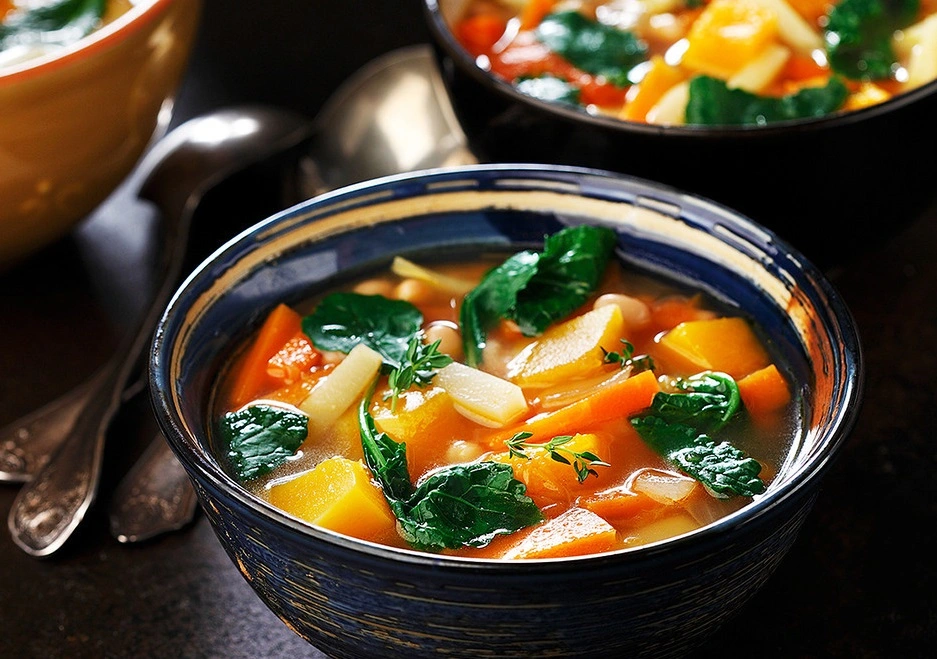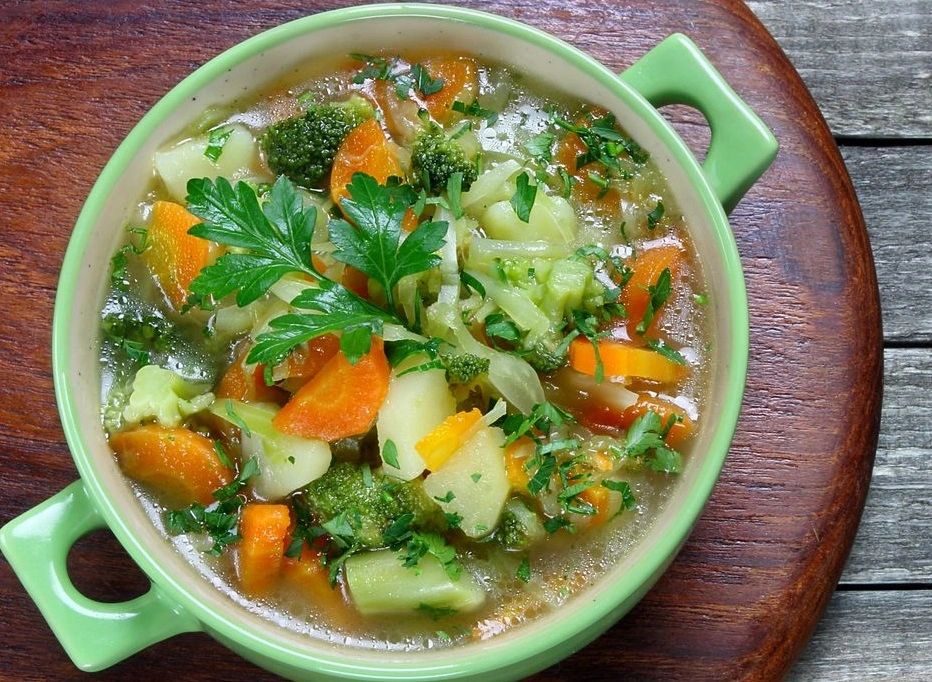Vegetable soup is more than just a bowl of warm, comforting goodness—it’s a versatile dish that can be tailored to suit any taste, diet, or season. Whether you’re looking for a light meal on a hot summer day or a hearty, warming dish in the winter, the perfect choice. Packed with nutrients and flavor, it’s no wonder that it’s is a staple in kitchens around the world.

History of Vegetable Soup
Soup, in its many forms, has been a part of human diets for centuries. The concept of boiling vegetables in water to create a nutritious broth dates back to ancient times, with each culture adding its unique twist. From the simple broths of the ancient Greeks and Romans to the rich, hearty soups of medieval Europe, this food has evolved into a universal comfort food enjoyed by people everywhere. Today, it remains a popular dish that transcends cultural boundaries, providing warmth and nourishment.
Health Benefits
is not only delicious but also incredibly healthy:
- Nutrient-Dense and Low in Calories: Vegetables are packed with essential vitamins and minerals, making this soup a nutrient powerhouse. Plus, it’s low in calories, making it a perfect choice for those watching their weight.
- High in Vitamins, Minerals, and Fiber: Ingredients like carrots, celery, and leafy greens are rich in vitamins A, C, and K, as well as minerals like potassium and magnesium. The high fiber content aids digestion and promotes a healthy gut.
- Aiding Digestion and Hydration: The broth in vegetable soup helps keep you hydrated, while the fiber from the vegetables supports healthy digestion.
- Ideal for Weight Management and Detox: With its low calorie and high nutrient content, vegetable soup is an excellent option for those looking to detox or maintain a healthy weight.
Key Ingredients
Here are some of the key ingredients:
- Vegetables: Carrots, celery, onions, potatoes, and tomatoes are classic choices, but you can use any vegetables you have on hand.
- Broth or Stock: Whether you use vegetable, chicken, or beef broth, it forms the flavorful base of your soup.
- Herbs and Spices: Fresh herbs like parsley, thyme, and bay leaves, along with spices such as black pepper and garlic, add depth to the flavor.
- Optional Add-Ins: For extra protein or texture, consider adding beans, lentils, rice, or pasta.
Types :
There’s a vegetable soup for every palate. Here are some popular variations:
- Classic V. Soup: A simple, clear broth with a variety of vegetables, perfect as a light meal or starter.
- Creamy V. Soup: Blended vegetables with cream or a dairy-free alternative create a rich, velvety texture.
- Mediterranean V. Soup: Featuring ingredients like zucchini, tomatoes, and olives, this version has a bright, tangy flavor.
- Asian-Inspired V. Soup: Incorporates ingredients like ginger, soy sauce, and bok choy for a flavorful, aromatic soup.
- Hearty Winter V. Soup: Packed with root vegetables, beans, and barley, this soup is a meal in itself.
Step-by-Step Guide to Making Classic Vegetable Soup

Making a delicious vegetable soup is easy with these steps:
- Preparing the Vegetables: Wash, peel, and chop your vegetables into even pieces to ensure they cook evenly.
- Choosing and Making the Broth: Start with a good-quality broth or stock, or make your own by simmering vegetables, herbs, and spices in water.
- Sautéing the Base Vegetables: Begin by sautéing onions, garlic, and celery in a bit of olive oil until they are soft and fragrant.
- Adding Remaining Ingredients and Simmering: Add the rest of the vegetables, along with the broth, and bring to a boil. Reduce the heat and let it simmer until the vegetables are tender.
- Adjusting Seasonings and Final Touches: Taste and adjust the seasoning with salt, pepper, and herbs before serving.
Variations :
You can customize vegetable soup to suit any dietary needs or preferences:
- Vegan V. Soup: Use vegetable broth and avoid any dairy or animal products.
- Gluten-Free V. Soup: Ensure all ingredients, including broth and any add-ins like pasta, are gluten-free.
- Low-Carb V. Soup: Focus on non-starchy vegetables and avoid grains or potatoes.
- Spicy V. Soup: Add chili flakes, cayenne pepper, or a dash of hot sauce for some heat.
- Slow Cooker V. Soup: Combine all ingredients in a slow cooker and let it cook on low for 6-8 hours for a hands-off meal.
Tips and Tricks for the Best Vegetable Soup
To make your v. soup truly outstanding, follow these tips:
- Balancing Flavors and Textures: Use a mix of vegetables for varied textures, and balance sweet, savory, and tangy flavors.
- Using Seasonal Vegetables for Freshness: Choose vegetables that are in season for the freshest taste and best nutritional value.
- Enhancing the Soup with Umami Ingredients: Add a splash of soy sauce, miso, or nutritional yeast to deepen the flavor.
- Achieving the Perfect Consistency: If your soup is too thin, let it simmer uncovered to reduce. If too thick, add a bit more broth.
Common Mistakes to Avoid
Even a simple dish like vegetable soup can go wrong if you’re not careful:
- Overcooking the Vegetables: Cook the vegetables until just tender to maintain their texture and nutrients.
- Adding Too Much Salt Early On: Wait until the soup has simmered before adding the final amount of salt to avoid oversalting.
- Not Using Fresh Herbs and Spices: Fresh herbs and spices will always deliver better flavor than dried or old ones.
- Overloading the Soup with Too Many Ingredients: Keep it simple. Too many ingredients can muddle the flavors.
Serving Suggestions
pairs well with various side dishes and garnishes:
- Ideal Side Dishes: Serve with crusty bread, a side salad, or a sandwich for a complete meal.
- Garnishing Ideas: Top with fresh herbs, grated cheese, a dollop of sour cream, or crunchy croutons.
- Pairing with Beverages: A glass of white wine, herbal tea, or even a cold beer can complement the flavors of the soup.
Storing and Reheating Vegetable Soup
Leftover vegetable soup is a gift that keeps on giving:
- Best Practices for Refrigeration and Freezing: Store in airtight containers in the fridge for up to 5 days, or freeze for up to 3 months.
- How to Reheat Without Losing Flavor or Texture: Reheat on the stove over low heat, stirring occasionally, to maintain the soup’s integrity.
- How Long Vegetable Soup Stays Fresh: Properly stored, vegetable soup remains fresh in the fridge for up to 5 days.
Vegetable Soup for Meal Prep
Vegetable soup is a meal prepper’s dream:
- Making Large Batches for the Week: Double the recipe and portion it into individual containers for easy grab-and-go meals.
- Portioning and Storing for Easy Meals: Freeze portions in zip-top bags or containers for quick meals on busy days.
- Using Leftover Soup Creatively: Add cooked grains, pasta, or protein to transform leftover soup into a new meal.
Special Diets : with Vegetable Soup
Here’s how to adapt vegetable soup for various dietary needs:
- Keto-Friendly Vegetable Soup: Focus on low-carb vegetables like spinach, zucchini, and broccoli.
- Paleo V.Soup: Use bone broth and avoid legumes and grains.
- Whole30 Compliant V. Soup: Stick to compliant vegetables, broth, and seasonings.
- V. Soup for Diabetics: Avoid starchy vegetables and opt for a low-sodium broth to manage blood sugar levels.
Why Vegetable Soup Is Perfect Year-Round
Vegetable soup is a dish for all seasons:
- Light and Refreshing for Summer: Use fresh, in-season vegetables and serve slightly chilled or at room temperature.
- Warm and Comforting for Winter: Add hearty root vegetables and serve steaming hot to warm up on cold days.
- Easy to Adapt to Seasonal Ingredients: Swap in-season produce into your soup to keep it fresh and flavorful all year long.
Conclusion
Vegetable soup is a timeless classic that offers endless possibilities for customization. Whether you’re looking for a quick, healthy meal or a comforting dish to warm you up, vegetable soup has got you covered. With its rich flavors, easy preparation, and numerous health benefits, it’s no wonder this dish remains a favorite in kitchens around the world. So why not try making your own? You might just discover a new go-to recipe!
FAQs
Can I use frozen vegetables in vegetable soup?
Yes, frozen vegetables work well and save time. Just add them directly to the soup without thawing.
How do I thicken vegetable soup without cream?
You can use a potato, blend part of the soup, or add a slurry of flour or cornstarch mixed with water.
Can I make vegetable soup in an Instant Pot?
Absolutely! Use the sauté function for the base, then cook on high pressure for 5-7 minutes.
What’s the best way to add protein to vegetable soup?
You can add beans, lentils, tofu, or cooked chicken to boost the protein content.
How long should I simmer vegetable soup?
Simmer the soup for at least 20-30 minutes, or until the vegetables are tender and flavors are well combined.
1 thought on “Vegetable Soup: A Comforting and Nutritious Classic”